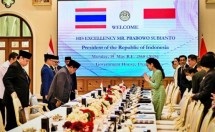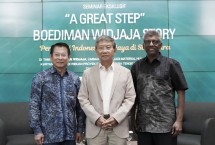R80 Aircraft Development Need an investment of US $ 1.5 Billion
By : Herry Barus And Aldi Firhand. A | Tuesday, August 08 2017 - 15:17 IWST

Head of BEKRAF Triawan Munaf Together with BJ Habibie and Ilham Habibie
INDUSTRY.co.id - Jakarta - The development of the R80 turboprop airplane designed by the Third President of the Republic of Indonesia BJ Habibie included in the National Strategic Project (PSN) requires 1.5 billion US dollars.
PT Regio Aviasi Industri (RAI) established by B.J Habibie with his eldest son Ilham Akbar Habibie will work on the development of the short-range regional aircraft.
"The funds are 1.5 billion US dollars, but 55 percent must come from within the country, that is what Pak Habibie's request is for the development of the aircraft to be certified," said Deputy Finance Director of PT RAI Funding Desra Firza Ghazfan when met by media crews at Habibie Festival JI Expo Kemayoran, Jakarta, Monday (7/8/2017)
Desra explained the need of the fund until now has not been fulfilled all. There is also a 55 percent R80 financing coming from within the country, among others through non-financial investment financing (PINA), private national, "crowd funding" and vendors.
Meanwhile, 35 percent of financing came from ASEAN and 30 percent from strategic partners.
Desra explained that several airlines, such as NAM Air, Kalstar, Trigana Ais and Aviastar have expressed their interest to book a total of up to 155 R80 aircraft through the Letter of Interest (LOI).
He detailed the order from NAM Air as much as 100 units, Kalstar 25 units, Trigana Air 20 units and Aviastar 10 units.
"Ordered by 'Letter of Interest' has 155 aircraft from 222 that we need to return capital, total we want to produce is actually 600 units," Desra said.
R80 aircraft that use twin-turboprop engine is a type of aircraft with a capacity of 80 to 92 passengers with a target regional middle market.
The advantages of this aircraft from its nearest competitor, the ATR-72 used by Garuda Indonesia, among others more efficient, convenient and economical, especially for a short distance with 400-800 nautical mile mileage or about 1400-1500 kilometers
Read Also
Binawan and Government Support Indonesian Nurses in Europe through…
MICE Activities at JCC Halted, PT GSP Continues Legal Process
The Current Industrial Development Policy Indonesia is On the Tight…
Getting to know Pablo Malay, GoTo’s new director
The Company's Trend of Shifting to Cloud Services Increases, MTDL's…
Today's Industry

Rabu, 21 Mei 2025 - 10:09 WIB
Indonesia, Thailand Sign MoU on Health Sector, Focusing on Global Capacity, Collaboration
As a part of President Prabowo Subianto’s official visit to Thailand, both countries signed a Memorandum of Understanding (MoU) on health sector, in an effort to strengthen bilateral cooperation…

Rabu, 21 Mei 2025 - 10:06 WIB
Indonesia, Thailand Deepen Cooperation on Security, Trade, and Regional Stability
resident Prabowo Subianto has reaffirmed Indonesia’s strong commitment to deepening bilateral relations with Thailand during the meeting with Thailand’s Prime Minister Paetongtarn Shinawatra…

Selasa, 20 Mei 2025 - 12:44 WIB
Boediman Widjaja's Technology Ready to be Adopted in Jababeka Industrial Estate (KIJA)
In an exclusive seminar entitled "A Great Step: Boediman Widjaja Story - Going from Indonesia, Thriving in Singapore" held at the President Lounge, Menara Batavia, Boediman Widjaja, Founder…

Jumat, 28 Maret 2025 - 22:21 WIB
SUNeVision Initiates MEGA IDC Phase Two Development
SUNeVision, the technology arm of Sun Hung Kai Properties (SHKP), today announced the commencement of construction for Phase Two of MEGA IDC in Tseung Kwan O. As Hong Kong's largest data centre…

Jumat, 28 Maret 2025 - 22:07 WIB
TDL Records New Revenue Record of IDR 25 Trillion in 2024 Ahead of 50th Anniversary
PT Metrodata Electronics Tbk (MTDL), the largest technology Company with the most complete IT and telecommunications products in Indonesia, managed to record a revenue of IDR 25 trillion in…
















News Comment